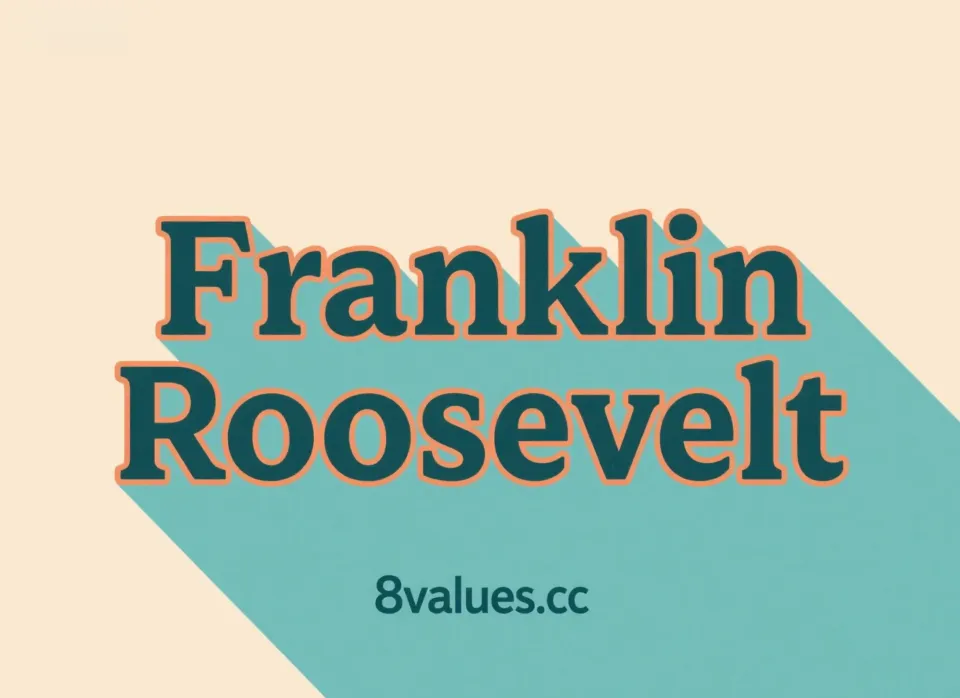Franklin D. Roosevelt: The New Deal, World War II and the Great President who Shaped the Post-War World Order
Franklin D. Roosevelt, the 32nd President of the United States, is the only US president in history to be re-elected for four terms. This article explains in detail his implementation of the "New Deal" to overcome the Great Depression, defeat domestic isolationism, lead the United States to win the Second World War, and his key role in establishing the United States' hegemony and shaping the post-war world order, especially the concept of state intervention and global cooperation involved in the 8values political ideological test website.
Franklin Delano Roosevelt (January 30, 1882-April 12, 1945) is referred to as FDR for short, and is often called "Roosevelt Jr." in the Chinese world. He is the 32nd president of the United States (term: 1933-1945), and is also the first and only president in American history to be re-elected for four terms (died in his fourth term). Roosevelt was named the best president of the United States many times and was named the fourth of the 100 people who influenced the United States by the Atlantic in 2006.
Early career and political temper
Roosevelt was born on January 30, 1882 in a wealthy and ancient family in Hyde Park, New York, USA. His father, James Roosevelt I, was an active figure in the diplomatic and business circles. Roosevelt's distant uncle Theodore Roosevelt was the 26th president of the United States.
After his mother Sara Ann Delano Roosevelt's enlightenment education, Roosevelt studied with a tutor and his life was strictly regulated. He was sent to the Groton School in 1896, which aims to train politicians. In 1900, Roosevelt entered Harvard University to study politics, history and journalism. During his time at Harvard, he was passionate about social activities and served as editor-in-chief of the school magazine "Crimson News". To maintain his reputation, he also studied for an extra year of graduate school at Harvard University.
In 1904, Roosevelt entered Columbia Law School. In March 1905, he married Anna Eleanor Roosevelt, the niece of cousin President Theodore Roosevelt. The president personally attended the wedding, which inspired Roosevelt's determination to enter politics. In 1907, after graduating from law school, Roosevelt began working as a lawyer.
In 1910, Roosevelt entered politics as a Democrat and was elected to the New York Senate. In 1913, he was appointed Assistant Secretary of the Navy by President Woodrow Wilson, during which he advocated the construction of a "strong and combat-capable navy." In 1920, after his failed run for vice president, he reopened his lawyer career and engaged in business activities.
In August 1921, Roosevelt suffered from polio (or Gillbap syndrome) while on leave, resulting in lifelong disability. But he did not give up his ideals, and he kept training unremittingly, facing challenges with perseverance and optimism. With the support of his wife, Roosevelt returned to politics in 1928 as governor of New York (1929-1932).
Responding to the Crisis and the "New Deal"
In 1932, as the Great Depression swept the United States, Roosevelt ran as a Democratic presidential candidate and proposed a program to implement the "New Deal" and revitalize the economy. He successfully defeated Herbert Clark Hoover and became President of the United States in 1933.
On March 4, 1933, Roosevelt made a famous declaration in his inaugural speech: " The only thing we fear is fear itself ." He then actively promoted the "Roosevelt New Deal" with relief, reform and revival as the main contents.
Economic Measures and Ideas of the New Policy
The "Roosevelt New Deal" abandoned the traditional laissez-faire, strengthened government intervention in the economic field , implemented deficit finance, and vigorously developed public utilities to stimulate the economy. He formed a think tank with a group of liberal experts and scholars, and innovatively strengthened contact with the people through "fireside conversation".
The main measures of the new policy include:
- Rectify the financial system : implement bank sanctions and restore bank credit, aiming to stabilize the financial capital market. He also implemented inflationary monetary policy and deficit fiscal policy, announcing the depreciation of the US dollar to improve the competitiveness of US goods in the international market and stimulate exports.
- Strengthen industrial guidance : Pass the National Industrial Revival Act (NIRA), etc., aiming to prevent overproduction caused by blind competition. The wage standards and working days stipulated also play a role in expanding consumption and alleviating social conflicts.
- Adjust agricultural policies : reduce agricultural output through rewards and compensation and other means to stabilize agricultural product prices.
- Implement "work-for-relief" : establishing public projects and other measures to expand domestic demand, stimulate production development, and regulate redistribution through the state.
The new policy from 1933 to 1934 focused on "revival", while the new policy from 1935 to 1939 focused on "relief" and "reform", such as the implementation of social insurance, extensive public engineering construction and tax reform. The success of the new policy has gradually restored American industry and agriculture, and national income has increased significantly.
Game with the Supreme Court
The "New Deal" encountered resistance in the implementation of the process, especially from the conservative US Supreme Court. The Supreme Court has rejected 12 important new policy bills. To address this challenge, Roosevelt proposed the "Court Filling Plan" in 1937, aiming to inject "fresh blood" by expanding the number of Supreme Court justices (from 9 to 15). Despite the setback of the plan in Congress, the Supreme Court then changed its attitude, and combined with seven justices retiring or passing away within the next five years, Roosevelt was able to nominate a new justice on his own, almost completely reshaping the Supreme Court.
Overcoming isolationism and "the arsenal of a democratic country"
Internationally, in the face of the formation of the German, Italian and Japanese fascists in Europe and Asia, the Roosevelt administration launched a complex diplomatic struggle.
Good neighborly policy and recognition of great powers
Before the outbreak of the European war, Roosevelt recognized the Soviet Union (USSR) in 1933 and established diplomatic relations with it. At the same time, he proposed the Good Neighbor Policy to improve relations with Latin American countries. This policy argues that no American country should interfere with the internal affairs of another American country and pursue a reciprocal trade agreement economically. Although the United States retained its economic advantages and control over the region, the policy promoted the resurgence of Pan-Americanism and ultimately led to the establishment of the Organization of American States.
Preparation for the Anti-Fascist War
Due to the prevalence of isolationism at home, the US Congress passed a neutral bill that prohibits the United States from exporting weapons and credit during wartime. Roosevelt fought resolutely with isolationism.
In 1937, Roosevelt delivered a Quarantine Speech, pointing out that war would spread like an infectious disease and that society had the right to isolate patients, but this remark was severely criticized. He then urged increased naval construction fees and promoted the adoption of the Vinson Act in 1938.
With Germany invading Poland, World War II broke out. Roosevelt successfully convinced Congress to abolish the embargo clause and implement the "cash and carry " principle, allowing belligerent countries to purchase non-military materials in cash and ship them with their own ships.
In 1940, the British and French coalition forces were defeated and Britain was in danger. Roosevelt began to provide weapons to the UK and took the presidential election as an opportunity to break the tradition of not being re-election for more than two terms established by President George Washington, and successfully became president for the third time.
In early 1941, Roosevelt introduced the Lend-Lease Act , advocating that the United States must become a " great arsenal of a democratic country ." The bill came into effect in March of the same year, authorizing the president to lease weapons and equipment to countries related to U.S. security. The passage of the Lease Act is an important milestone in the United States' active intervention in the anti-fascist war. In August of the same year, Roosevelt and Winston Churchill held talks and issued the Atlantic Charter.
Allied leaders and the construction of post-war order
United States Participation and War Mobilization
On December 7, 1941, Japan attacked Pearl Harbor Incident. Subsequently, the United States and Britain declared war on Japan, Germany and Italy declared war on the United States, and the United States officially participated in World War II.
Roosevelt ordered the implementation of war mobilization, which enabled the United States' military production capacity to rapidly expand and achieve full employment. Before the end of the war, the number of US armed forces reached more than 15.14 million. He reorganized the military command organization and formed the Joint Chiefs of Staff, composed of George Marshall and others, to implement unified command of the armed forces.
In December 1941, Roosevelt and Churchill held an Arcadia meeting in Washington, reaffirming that the allied strategy was "first in Europe", that is, to defeat Nazi Germany first.
The formation of the international anti-fascist alliance
Under the advocacy of Roosevelt, representatives of 26 countries including the United States, Britain, the Soviet Union and the Middle School signed the Declaration by United Nations on New Year's Day 1942, and the International Anti-Fascist Alliance was officially formed.
In the middle of the war, Roosevelt actively coordinated the combat operations of the allies and discussed post-war policies, and held a series of important meetings.
- Casablanca Conference (1943): Roosevelt and Churchill decided to implement the principle of "unconditional surrender" to the Axis powers.
- Cairo Conference (November 1943): Roosevelt, Churchill, and Chiang Kai-shek, President of the Kuomintang and Chairman of the Military Commission, were held in Egypt. The Cairo Declaration was signed, stipulating that the territory stolen by Japan should be returned to China and that North Korea should be free and independent.
- Tehran Conference (November-December 1943): Roosevelt and Churchill met with the Supreme Soviet Commander-in-Chief of the Soviet Union , Joseph Stalin , to discuss issues such as opening up the second battlefield in Europe (the "Overlord" Project) and post-war international organizations.
In 1944, Roosevelt was elected President of the United States for the fourth time with a 53% vote.
Establishing the United Nations
Roosevelt was a loyal Wilsonian who believed that collective security was the ultimate goal of national security. He hopes to establish an effective international organization to maintain post-war peace.
In 1942, Roosevelt had envisioned the establishment of an institution composed of the Four Policemen of the United States, Britain, the Soviet Union and China, responsible for maintaining the world's public order and preventing aggression. Although there were difficulties in specific operation, this collective security idea gradually developed and eventually transformed into the idea of establishing a world-wide international organization .
In February 1945, Roosevelt, Churchill and Stalin held the Yalta Conference in the Crimean Peninsula. The meeting reiterated that Nazi Germany had to surrender unconditionally, and discussed important issues such as Germany's post-war disposal and the United Nations. The meeting guaranteed the United States to become a member of the United Nations.
Sudden death and historical heritage
On April 12, 1945, Roosevelt died of a sudden cerebral hemorrhage at Warm Springs, Georgia. During his fourth term, he held only 73 days of his post. His death occurred at the height of the war, and it was the moment when American policies needed his authoritative guidance the most. Roosevelt's re-election for four presidents is extremely important to both the American political system and the world anti-fascist war.
Historical evaluation
Roosevelt has been listed as one of the greatest American presidents in history, often tied with Abraham Lincoln and George Washington.
- The then British Prime Minister Churchill highly praised him as a politician, doer and military leader, and praised his "beating magnanimous heart".
- Some biographers believe that he "lifted himself out of a wheelchair and liberated the entire country in surrendering itself."
- The new policy he implemented strengthened federal government institutions, quickly expanded the role the government should play in the United States, and redefined liberalism in the minds of future generations. Roosevelt also solidly established the United States' leadership role on the world stage.
Character controversy
Roosevelt's political legacy is not without controversy:
- Civil Rights Question : His civil rights record was controversial, especially during World War II, when he ordered the detention of Japanese, Italian and German Americans in 1942 (many were not released until after the war).
- Concentration of power : Because of his long-term presidency and his rapid expansion of government power during the two major crises, he has been accused of having a dictatorial tendency to consolidate power.
- Pearl Harbor's "Bitty Fruit Scheme" : There is an international view of "Bitty Fruit Scheme" that in order to get rid of the obstruction of domestic isolationist forces, Roosevelt foresaw and "allowed" the occurrence of the Pearl Harbor incident in advance, which angered the American people's emotions and successfully joined the war. Supporters cite evidence of transferring away from the aircraft carrier and secretly mobilizing medical supplies in advance. However, this view remains an unsolved mystery due to the lack of the most powerful and direct evidence.
Anecdotes and Memorials
Roosevelt is a leader full of personality, leaving behind many anecdotes and important memorials:
- Philatelic collector : Roosevelt has been collecting philatelic since he was 10 years old and has been collecting more than 1.2 million stamps. During his presidency, both philatelics and stamp sales in the United States increased significantly. He even personally participated in the design of multiple stamps.
- "Dogs care" : During the 1944 presidential election, Republicans attacked Roosevelt who sent destroyers to rescue his dog Fala. Roosevelt responded boldly: "I don't care about the Republican attacks, my wife doesn't care, my son doesn't care, but my dog Farah, it cares!" This quickly changed from passive to active, winning voter support for him. Now, next to the statue of Roosevelt in Washington, Farah is also standing.
Roosevelt's avatar appeared on the US 10 cents coin (i.e. "Roosevelt 10 cents"). His former residence, including his home in Hyde Park, New York and a resting place in Georgia Hot Springs, have become important memorial sites. In addition, in order to commemorate his contribution to the anti-fascist war and his assistance to China's war of resistance, the "National Roosevelt Library" was established in Chongqing and is now open to the public as the "Old Site of the Roosevelt Library".
Exploring political tendencies: Roosevelt’s new policy represents a strong government intervention in the market economy, which reflects to a certain extent the pursuit of equality and emphasis on collective welfare in his political values, which is directly related to some dimensions in the 8 values political values tendency test . If you are interested in how Roosevelt’s political philosophy influences modern political thoughts, you can explore your personal values through testing. For more content, please continue to browse our official blog







